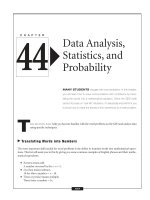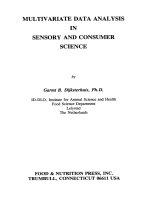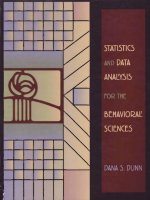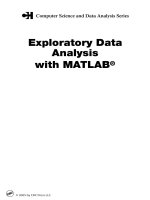MULTIVARIATE DATA ANALYSIS INSENSORY AND CONSUMERSCIENCEGarmt B. Dijksterhuis, Ph.D.ID-DLO, Institute for Animal Science and Health Food Science Department Lely stad The NetherlandsFOOD & NUTRITION PRESS, INC. TRUMBULL, CONNECTICUT 06611 USA.MUL doc
Bạn đang xem bản rút gọn của tài liệu. Xem và tải ngay bản đầy đủ của tài liệu tại đây (10.45 MB, 320 trang )
MULTIVARIATE DATA ANALYSIS
IN
SENSORY
AND CONSUMER
SCIENCE
Garmt
B.
Dijksterhuis, Ph.
D.
ID-DLO, Institute
for
Animal Science and Health
Food Science Department
Lely stad
The Netherlands
FOOD
&
NUTRITION
PRESS,
INC.
TRUMBULL, CONNECTICUT
06611
USA
MULTIVARIATE DATA ANALYSIS
IN
SENSORY AND CONSUMER
SCIENCE
MULTIVARIATE DATA ANALYSIS
IN
SENSORY AND CONSUMER
SCIENCE
F
N
P
PUBLICATIONS
IN
FOOD SCIENCE AND NUTRITION
Books
MULTIVARIATE DATA ANALYSIS, G.B. Dijksterhuis
NUTRACEUTICALS: DESIGNER FOODS
111,
P.A. Lachance
DESCRIPTIVE SENSORY ANALYSIS IN PRACTICE, M.C. Gacula, Jr.
APPETITE FOR LIFE:
AN
AUTOBIOGRAPHY, S.A. Goldblith
HACCP: MICROBIOLOGICAL SAFETY OF MEAT, J.J. Sheridan
er
al.
OF MICROBES AND MOLECULES: FOOD TECHNOLOGY AT M.I.T., S.A. Goldblith
MEAT PRESERVATION, R.G. Cassens
S.C. PRESCOlT, PIONEER FOOD TECHNOLOGIST, S.A. Goldblith
FOOD CONCEPTS AND PRODUCTS: JUST-IN-TIME DEVELOPMENT,
H.R.
Moskowitz
MICROWAVE FOODS: NEW PRODUCT DEVELOPMENT, R.V. Decareau
DESIGN
AND
ANALYSIS OF SENSORY OPTIMIZATION, M.C. Gacula,
Jr.
NUTRIENT ADDITIONS TO FOOD, J.C. Bauernfeind and P.A. Lachance
NITRITE-CURED MEAT, R.G. Cassens
POTENTIAL FOR NUTRITIONAL MODULATION OF AGING, D.K. Ingram
ef
al.
CONTROLLEDlMODIFIED ATMOSPHERENACUUM PACKAGING, A. L. Brody
NUTRITIONAL STATUS ASSESSMENT OF THE INDIVIDUAL, G.E. Livingston
QUALITY ASSURANCE OF FOODS, J.E. Stauffer
SCIENCE OF MEAT
&
MEAT PRODUCTS, 3RD ED., J.F. Price and B.S. Schweigert
HANDBOOK OF FOOD COLORANT PATENTS, F.J. Francis
ROLE
OF
CHEMISTRY IN PROCESSED FOODS, O.R. Fennema
et
al.
NEW DIRECTIONS FOR PRODUCT TESTING OF FOODS, H.R. Moskowitz
ENVIRONMENTAL ASPECTS OF CANCER: ROLE OF FOODS, E.L. Wynder
et
al.
PRODUCT DEVELOPMENT
&
DIETARY GUIDELINES, G.E. Livingston,
et
al.
SHELF-LIFE DATING OF FOODS, T.P. Labuza
ANTINUTRIENTS AND NATURAL TOXICANTS IN FOOD, R.L.
Ory
UTILIZATION OF PROTEIN RESOURCES, D.W. Stanley
et
al.
POSTHARVEST BIOLOGY AND BIOTECHNOLOGY, H.O. Hultin and
M.
Milner
Journals
JOURNAL
OF
FOOD LIPIDS,
F.
Shahidi
JOURNAL OF RAPID METHODS AND AUTOMATION IN MICROBIOLOGY,
D.Y.C. Fung and M.C. Goldschmidt
JOURNAL OF MUSCLE FOODS, N.G. Marriott, G.J. Flick, Jr. and J.R. Claus
JOURNAL OF SENSORY STUDIES, M.C. Gacula, Jr.
JOURNAL OF FOODSERVICE SYSTEMS, C.A. Sawyer
JOURNAL
OF
FOOD BIOCHEMISTRY, N.F. Haard, H. Swaisgood and B. Wasserman
JOURNAL OF FOOD PROCESS ENGINEERING, D.R. Heldman and R.P. Singh
JOURNAL OF FOOD PROCESSING AND PRESERVATION, D.B. Lund
JOURNAL OF FOOD QUALITY, J.J. Powers
JOURNAL OF FOOD SAFETY, T.J. Montville and D.G. Hoover
JOURNAL OF TEXTURE STUDIES, M.C. Bourne and M.A. Rao
MICROWAVES AND FOOD, R.V. Decareau
FOOD INDUSTRY REPORT, G.C. Melson
FOOD, NUTRITION AND HEALTH, P.A. Lachance and M.C. Fisher
Newsletters
MULTIVARIATE DATA ANALYSIS
IN
SENSORY
AND CONSUMER
SCIENCE
Garmt
B.
Dijksterhuis, Ph.
D.
ID-DLO, Institute
for
Animal Science and Health
Food Science Department
Lely stad
The Netherlands
FOOD
&
NUTRITION
PRESS,
INC.
TRUMBULL, CONNECTICUT
06611
USA
Copyright
1997
by
FOOD
&
NUTRITION
PRESS,
INC.
4527Main Street,
POB
374
Trumbull, Connecticut
0661
I
USA
All rights reserved.
No
part
of
this publication may be
reproduced, stored
in
a
retrieval system or transmitted
in
any
form
or by any means: electronic, electrostatic,
magnetic tape, mechanical, photocopying, recording or
otherwise, without permission in writing
from
the
publisher.
Library
of
Congress Catalog Card Number:
97-061
692
ISBN:
0-91
7678-41-9
Printed
in
the United States
of
America
DEDICATION
To
my father
and
mother
V
This book is the result of research into the applicability of Multivariate
Data Analysis to the results of sensory studies. During the years I worked
on
this topic, I learned a lot, and had the opportunity to write down some of the
things
I
had just learned. Of course, the credits are not all mine: I owe a lot to
my teachers and colleagues, some of which appear as first or co-authors of
papers in this book.
I
want to spend some words thanking them while at the
same time sketching the history of this book.
Near the finishing of my study in psychology with Prof. Ep Koster at
the University of Utrecht, Stef van Buuren suggested Overals
as
an interesting
alternative for Procrustes Analysis, to analyse sensory data. This set me off in
the direction of what I would now call Sensometrics. In
1987
I started working
at Oliemans Punter
&
Partners, a small company that performs sensory and
consumer research. The cooperation with Pieter Punter resulted, among other
things, in a joint paper on Procrustes Analysis. Pieter would always put my nose
in the direction of the applicability of MVA for sensory problems, which were
useful lessons for me. In retrospect it occurs to me that I wrote almost all papers
while I worked there. This is quite uncommon for such a small private
company.
I’m
afraid
I
never explicitly thanked them for this, but hope to have
put it right now.
The cooperation with Eeke van der Burg resulted in a number of
papers, four of which are included in this book.
I
learned a lot from our
cooperation, especially about the Gifi system and in particular about canonical
analysis, redundancy analysis and their nonlinear extensions. Eeke is the first
author of these four papers, which shows in the mathematical introductions. I
thank her for never becoming tired when over and over again explaining some
of the mathematics
to
me.
Another inspiring teacher was
John
Gower. His telling me about
high-dimensional intersections of category-hyperplanes, with appropriate
gesticulation and scribbles on the blackboard gave me another view on data
analysis. We wrote two papers together of which one is included in the book.
John
is the first author, which shows in the generality of the method and its
mathematical presentation.
In addition to teachers
I
thank my former colleagues at OP&P’s for the
discussions about a gamut of topics, some of which were sensory science and
statistics. Margo Flipsen and Els van den Broek deserve special mention. They
visited OP&P to do some Time-Intensity studies for their master’s thesis at the
Agricultural University of Wageningen. They appear as co-authors on two
papers on the analysis of TI-data.
vii
Prologue
and
Acknowledgments
This book served as my Ph.D. thesis, at the department of Datatheory,
at the University of Leiden. The main threat to the thesis ever coming to an end
was I. Every now and then I would lose myself in a “very interesting”
side-track of Multivariate Data Analysis. It was Willem Heiser who, by patiently
and repeatedly telling me that I should focus on “sensory applications”, put me
back
on
the track again. Over the years he must have told me this several times,
and it helped.
Ann Noble (University of Davis, California, USA) had become a kind
of e-mail consultant to me. I thank her for her prompt answering of my
questions, providing references, and commenting
on
some of my writing.
My current job is at the Food Science Department of ID-DLO, the
Institute for Animal Science and Health (Lelystad, the Netherlands), leading
their sensory laboratory. ID-DLO is one of the major research institutes
on
animal production. In their Food Science Department resides the research on the
eating quality and safety of meat, eggs and dairy products mainly, in relation to
the processing required to produce a palatable food. At this sensory laboratory
I plan to explore some of the newer directions
in
sensory and consumer science
outlined in this book.
Finally there are a number of people that, in some way or another,
helped with the finishing of this book. To be sure to include them all, I do not
give names, but
I
thank them all. However, one name must be mentioned.
Because the preparation of the thesis was not part of my job, a lot of the writing
took place at home,
Gerjo is thanked for her patience, enthusiasm and
organisational talents I needed to finish this project.
GARMT B. DUKSTERHUIS
AMMERSTOL
viii
CONTENTS
Prologue and Acknowledgements
vii
1
1.1
1.2
1.3
1.4
1.5
1.6
1.7
1.8
1.9
1.10
Introduction
14
Research Question
14
Sensory Science
15
Sensory Research and Sensory Profiling Data
18
Sensory Profiling
22
Individual Differences
26
Measurement Levels
29
Sensory-Instrumental Relations
37
Time-Intensity Data Analysis
41
Structure of the
Book
48
Data Analysis. Confirmation and Exploration
43
PART
I:
INDIVIDUAL
DIFFERENCES
Introduction to
Part
I
53
2
Assessing Panel Consonance
2.1
Introduction
59
2.2
Data Structure
60
2.3
Method
61
2.4
Examples
63
2.5
Conclusion
75
3
3.1
Introduction
77
3.2
Two Different Procrustes Methods
78
3.3
Sums-of-squares in Generalized Procrustes Analysis
79
Interpreting Generalized Procrustes Analysis “Analysis
of
Variance”
Tables
3.4
Scaling the Total Variance
82
3.5
Generalized Procrustes Analysis
of
a Conventional Profiling
Experiment
83
ix
Contents
3.6 Generalized Procrustes Analysis of a Free Choice Profiling
Experiment
90
3.7 Conclusion
96
Concluding Remarks
Part
I
97
PART
II:
MEASUREMENT
LEVELS
Introduction to
Part
I1
103
4
4.1 Introduction
110
4.2 Data
111
4.3 Methodology
114
4.4 Analyses
120
4.5 Conclusion
133
Multivariate Analysis of Coffee Images
5
Nonlinear Canonical Correlation Analysis of Multiway Data
5.1 Introduction
135
5.2 K-Sets Homogeneity Analysis
136
5.3
K-Sets Canonical Correlation Analysis
138
5.4 An Application
of
Overals
to
Multiway Data
140
5.5
Conclusion
146
6 Nonlinear Generalised Canonical Analysis: Introduction and Application
from Sensory Research
6.1 Introduction
149
6.2 Generalised Canonical Analysis
151
6.3 Nonlinear Generalised Canonical Analysis
153
6.4 Application from Sensory Research
155
6.5 Results
158
6.6 Conclusion
161
X
Contents
Concluding Remarks Part I1
162
PART
III:
SENSORY-INSTRUMENTAL
RELATIONS
Introduction to Part I11
167
7
7.1
7.2
7.3
7.4
7.5
7.6
7.7
An
Application
of
Nonlinear Redundancy Analysis
Introduction
173
Redundancy Analysis
174
Optimal Scaling
175
Apple Data
176
Results For Cox Apples
178
Results For Elstar
181
Conclusion
183
8 An Application
of
Nonlinear Redundancy Analysis and Canonical
Correlation Analysis
8.1 Introduction
185
8.2 Techniques
186
8.3 Description
of
the Data
187
8.4 REDUNDALS Results
189
8.5 CANALS Results
191
8.6 Conclusions
192
9 Procrustes Analysis in Studying Sensory-Instrumental Relations
9.1 Introduction
195
9.2 Data
197
9.3 Procrustes Analysis
198
9.4 A First Look at the Data: PCA
200
9.5 Matching the Sensory and Instrumental Data Sets
205
9.6 Conclusion
209
xi
Contents
Concluding Remarks Part I11
211
PART
IV:
TIME-INTENSITY
DATA
ANALYSIS
Introduction to Part IV
217
10 Principal Component Analysis
of
Time-Intensity Bitterness Curves
10.1 Introduction
223
10.2 Data
224
10.3 Principal Curves
228
10.4 Non-Centered PCA
232
10.5 Further Considerations
234
1 1 Principal Component Analysis
of
Time-Intensity Curves: Three Methods
Compared
11.1 Introduction
235
11.2 Method
237
1 1.3 Principal Curve Analysis
241
1 1.4 Non-Centered Principal Curves
242
11.5 Covariance Principal Curves
249
1 1.6 Correlation Principal Curves
250
11.7 Conclusion
252
12
12.1 Introduction
255
12.2 Method: Shape Analysis
256
12.3 Examples
258
12.4 Conclusion
267
Matching the Shape
of
Time-Intensity Curves
Concluding Remarks Part IV
268
xii
Contents
13
Concluding Remarks
13.1
Introduction
13.2
PART
I:
Individual Differences
13.3
PART
11:
Measurement Levels
13.4
PART
111:
Sensory-Instrumental Relations
13.5
PART
IV:
Time-Intensity Data Analysis
13.6
Closing Remarks
References
Abbreviations and Acronyms
Subject Index
AuthorIndex
273
274
278
281
282
284
285
299
301
305
xiii
CHAPTER
1
Introduction
Summary
In this introduction the basic terminology of the subject matter of this
book is introduced. The underlying research question of the study is presented
and the four main themes that the chapters cover are described and related to
this question. The kind of data that
are
analysed throughout the book is
explained. Furthermore, the aim and the structure of the book are explained.
1.1
Research
Question
This book is concerned with problems from sensory and consumer
research. What exactly these kinds
of
research are is defined later. The tools
used to study the problems are the apparatus of Multivariate Data Analysis. The
underlying question that
is
addressed by the research in this book is:
14
1.
Introduction
What has Multivariate Data Analysis to offer for studying problems in
sensory research?
Asking
a
question like this is more or less “upside down”. Usually
when one is confronted with a scientific problem, an experiment is designed to
study it or to test a hypothesis. The reason that this is turned around in this book
is that the problems in sensory science that the author
was
confronted with, were
often such that the data were already collected. It was the feeling of both the
sensory researchers and the author that “There’s more than meets the eye in this
data set.”
1.2
Sensory Science
Sensory science is the general heading under which the study of many
different problems and the application of methods can be found.
No
complete
picture of sensory science will attempted to be given here. A concise history and
overview of the field can be found in Stone and Sidel (1985, 1993), McBride
(1990) and Punter (1991).
I.
2.
I
Some Definitions
defined as follows:
The part of Sensory Science that this book is concerned with can be
Sensory evaluation is a scientific discipline used
to
evoke,
measure, analyse and interpret reactions to those character-
istics of foods and materials
as
they are perceived by the
senses of sight, smell, taste, touch and hearing.
This definition was used by the (U.S.) Institute of Food Technologists
in 1975 and quoted by Stone and Sidel (1985). The definition is very general,
but it contains most ingredients of the discipline
as
it will be presented in this
book. The focus in this book will be on the
analysis
of the
reactions
to certain
characteristics
of
food
products (italics refer
to
the ingredients
of
the definition).
The
reactions
to
characteristics
will be in the form of scores given to attributes
perceived in the food-stimuli, the analyses will be multivariate and the
senses
will mainly be the senses of
smell
and
taste.
The field has
many
names, which may stress different aspects of
Sensory Science, but globally the same problems underlie all sub-disciplines.
Thomson (1988) poses the question:
15
1.
Introduction
What are the attributes that consumers perceive in a particular
new food product and in what ways will these combine to
determine future purchase decisions?
as one of the most obvious questions
to
be answered by the scientific discipline
coined “Food Acceptability”. He also describes “Food Acceptability” as a
somewhat uncomfortable marriage between food science and behavioural
psychology.
In an attempt to consolidate this marriage, a third party is
introduced in this book: data analysis.
McBride
(1990)
gives
an
overview of the position of sensory evaluation
in between the other disciplines:
1.
2.
consumer and marketing research with a behavioural and
Note that the marriage Thomson
(1988)
referred to is reflected here
too. A lot of bridges can be, and are being, built between the different
disciplines involved (see e.g. Thomson
et al.
1988).
In this book a bridge is
being developed based on statistics and data analysis.
research and development with a food-technical focus
psychological focus
1.2.2
Sensory and Consumer Science and Related Disciplines
A brief layout along simple lines will be given here to explain further
the subject matter
of
this
book.
From now on the term
Sensory and Consumer
Science
will be adopted, because it reflects reasonably well the contents of the
field. It is set apart from the study of the chemical senses, which is commonly
referred to
as
Sensory Psychology and Sensory Physiology (e.g. Koster
1971,
de Wijk
1989).
Such research is not of concern in this book. The (chemical)
senses can also be studied in connection
to
psychological properties
of
the
experimental subject. In this case behavioural responses may (be attempted to)
be modelled mathematically and the properties of the models studied. This kind
of research is historically linked to psychophysics and psychometrics. Recent
psychophysical studies with applications in sensory science and psychophysics
were performed by Frijters
(1980)
and Ennis
(1991).
This field is again not the
subject of this book.
Figure
1’
presents an overview of the different parts
Sensory and
Consumer Science
contains.
‘This figure is based on
a
suggestion
by
Pieter Punter.
16
1.
Introduction
Figure
1
Overview of Sensory and Consumer Science, illustrating the differences in focus
(1
:
on
products;
2:
on consumers).
As
is illustrated in Figure 1, Sensory and Consumer Science and
1. the study of products
2.
the study of consumers
In
the study of products, mainly trained assessors are used to judge the
products
on
rather technical or analytical attributes. This is what is meant by
perception,
in
the figure, in contrast to
appreciation.
The hedonic quality
appreciation
of the products is of
no
concern in this type of sensory research.
Both appreciative and perceptive aspects are used in the consumer
focused studies. The perceptive part uses consumer characterisations of the
products, rather than technical/analytical attributes. The appreciative part may
include measurement of the ideal intensity of the attributes and/or the
preferences of the consumers.
Product-oriented research has a clear relation to
R&D
and product
development. Consumer-oriented sensory research in addition has a relation to
marketing research.
In
this book, the focus is
on
the products rather than
on
the consumer.
The perception will mainly involve taste and smell properties of the products,
though visual, auditory (e.g. Vickers 1983, 1991) and kinaesthetic perceptions
are by no means excluded from Sensory and Consumer Science.
The distinction in Figure 1 is not
so
strict
as
the figure may suggest.
Sensory profiling studies are usually of an analytical nature, hence often found
in perception-studies. They try to answer the question: “What are the important
marketing/consumer research can be subdivided into two main fields:
17
1.
Introduction
attributes of the products?” They can be applied in appreciation studies too.
Then the question: “What products are
preferred/accepted/appreciated
by the
consumers?” is answered. It is a matter of choosing the attributes. In
appreciation studies, the attributes are fixed and will be mostly hedonic and
focusing
on
aspects
of
the quality
of
the products. Profiling studies will be
introduced in more detail in later sections
(81.4).
In Sensory-Instrumental research, the relations between physical/
chemical
(instrumental)
properties and the sensory properties of products are
studied. The focus of these studies is mainly analytical, i.e., they are
perception-studies. However, they may be conducted in an appreciation context,
provided that special attention is given to the relations between the instrumental
and the sensory-appreciative (see e.g. Noble
1975).
Sensory-Instrumental
research is covered in more detail in section
1.7
and is the subject of Part 111.
Time-Intensity research
(81.8
and Part IV) is focused on perception
only. The time-course of a particular perceived property
of
a product is studied.
1.3
Sensory Research and Sensory Profiling Data
The questions dealt with in this book are from the field of sensory and
consumer science. In general terms, this is the field of research in which
people
use their senses to
describe
certain
properties
of
objects.
Admittedly this
definition is too general and needs narrowing.
Three entities constitute the research and the resulting data
in
this book:
-
Objects
-
People
-
Descriptions (of properties)
Objects
can be interpreted very broadly. People can describe physical
objects, other people, services, etc. Other terms used are
products
or,
borrowed
from psychology,
stimuli.
The
descriptions
can take different forms. They can be a judgement of
the quality of an object, its hedonic value or another specific property. In this
book,
the descriptions will take the form
of
judgements of
a
particular sensory
property
of
the object, e.g. its sweet taste, its colour, its bitterness or the
roughness of its surface. These properties will be called
attributes,
and they
constitute the
variables
of the research in the sequel. A variable may consist of
numerical scores, or of a number of (ordered) categories.
18
1.
Introduction
In
sensory research the data are almost exclusively elicited
frompeople.
One of the directions in sensory and consumer science is research of products
with the use of sensory panels, sensory profiling studies. A sensory panel is a
group of people who give judgements about products. There are different kinds
of sensory panels, some of which will be introduced in a following section.
The products in the case of sensory research are food products, drinks,
cosmetics or luxuries like snacks, candy or tobacco. The products are evaluated
using essentially all senses (sight, hearing, smell, touch and taste) though
depending on the specific research question the focus may be
on
just one or two
of them.
In
purely analytical taste and/or smell studies, the appearance of
different products will be controlled for by e.g. using special lighting conditions.
Another modality is texture perception in the mouth. This sense is important
when judging products where texture plays a role e.g. in meat. Sight and even
hearing also play a part in sensory research. The appearance of products may
be important, depending on the kind of research. The sound of potato chips
during chewing is an example of use of the auditive sense in judging edible
goods (see also Vickers
1991).
1.3.1
Sensory-, Consumer- and Marketing Research
Sometimes the line between sensory, consumer and marketing research
is very thin indeed. Often a sensory panel receives a certain amount of training
in the judging task that is expected
of
them. The term
consumer panel
is
sometimes reserved for a group of judges that are not trained with respect to
their task. They are sometimes described
as
(or in fact) “picked up from the
street”, but it also happens that such a panel receives
a
limited amount of
training.
No
clear standard terminology seems to exist. Matters may get more
complicated when the term marketing-research is included in the picture too.
Is
sensory research a special case of consumer research, which is a special case of
marketing research? It proves hard to answer this question and perhaps
it
is even
harder to consolidate sensory researchers with consumer and marketing
researchers. Van Trijp
(1992,
see also Figure
2)
makes a distinction between the
different types of product that are studied by the different disciplines. Sensory
research studies the
core product,
i.e. a product with certain physical/chemical
(“instrumental”) characteristics of which the sensory characteristics are sought.
This is the study of the
perception
of products as presented in
51.2.2.
The
generic product
possesses certain derived “benefits”
as
usage utility, ease of use,
perceived durability and a “status”. This generic product is different from the
19
1.
Introduction
core product, though the same physical product may underlie both. Consumer
or marketing research is concerned with studying the generic products.
Figure 2 illustrates the relations between the fields of sensory,
consumer and marketing research.
I
I
I
I
I
I
,
I
I
1
core
rn
x-
I
1-
-I
-I
intrinsic
product
characteristics
__-__
f
extrinsic
product
characteristics
Figure
2
Relations between sensory, consumer and marketing research, showing
the
differences
between
core products
and
the
generic
products
(slightly adapted from van Trijp
1992).
Figure 2 shows the “classic” point of impact
of
sensory analysis,
studying the intrinsic product characteristics (the
core
product) for research and
development. The two double arrows between the intrinsic and extrinsic product
characteristics, and between
R&D
and marketing, indicate an interesting
potential application of sensory analysis and marketing, viz. the study of to what
extent sensory perception is influenced by properties
of
the “generic” product
such as price, packaging, brand labelling, and the derived characteristics
of
the
generic product.
Sensory research and consumer/marketing research have different,
though both psychological, origins. Sensory research is based in sensory
physiology and psychology and has, through psychophysics, always had a link
with statistics and psychometrics (see e.g. Punter 1991). Marketingkonsumer
research has its origins in social psychology, and it has a strong link to direct
applications in marketing. Sensory research is perhaps less applied than
marketing/consumer research, in that it is closer to research and development
of
products, and further away from the market (see also 01.2.1, Thomson 1988,
McBride 1990).
20
1.
Introduction
I
.3.2
Sensory Panels and Ditto Data
There are a number of different ways to collect sensory profiling data,
using different kinds of sensory panels. One important aspect in which these
methods of data collection differ is in the amount of training of the panels
receive prior to the actual experiment. Figure
3
arranges the different
panel-types along a continuum with respect to the amount of training they
receive.
no
training
intm‘ve
training
7
I
I
I
I
I
field consumer Free Quantitative
Spectrum
expert
Choice Descriptive
Profiling
Analysis
-
(Free
Choice
Profiling)
Figure
3
“Sensory panel method continuum”, ranging from untrained panels at
the
left to panels
that receive much training at the right.
The sensory analytical panels are located at the right extreme of this
continuum. These panels judge a limited set of products
on
a number of strictly
defined properties, with respect to which they have been intensively trained.
They are sometimes referred to as
expert
panels. At the other end of the
continuum in Figure
3
the consumer panels reside. Here one moves closer to
marketing research. The most extreme example is probably found in “mobile
testing” where the research takes place in a prepared bus which drives up to a
shopping centre and invites people in
to
judge products. These panels may be
called
field
panels, to distinguish them from
consumer
panels
in which
inexperienced consumers are invited to take place in a sensory experiment inside
a laboratory, or at least in a somewhat more controlled environment than a bus.
In between the field-panels and the expert-panels a lot of different sensory-panel
methods exist of which some are indicated in Figure
3.
The differences between
the
QDA
panel and the
Spectrum
panel method are not fundamental, and they are
not explained here (see Stone and Side1 1985, 1993 for
QDA,
Meilgaard
et al.
1990 for Spectrum). These two methods have in common that a standard
vocabulary of descriptive attributes is formed. These attributes are used in the
sensory experiment after the panel receives training with respect to the
21
1.
Introduction
attributes. The differences between the methods lie in the amount of and
procedures of training of the sensory panel.
Another way of distinguishing between different panels is in terms of
the kind of questions the judges are asked. A sensory panel is also referred to
as an
analytical
sensory panel when the questions in the experiment apply to
analytical, as opposed to hedonic, properties of the products.
This
division is
also present in Figure
1,
where the term “perception studies” is used for
“analytical,” and “appreciation studies” for “hedonic studies.” Examples of
analytical attributes are sweet taste, nutty taste, sticky odour, rubbery texture,
etc. The further we move to the right on the continuum in Figure
3,
the less
likely it is that hedonic questions will be asked. Hedonic studies are not
explicitly covered in this book. However, when analytical attributes are replaced
by hedonic attributes, or just by one hedonic attribute, most MVA methods
discussed in this book can be used for hedonic sensory profiling studies
as
well.
Free Choice Profiling panels differ not only in the amount of training,
but also in another property (see
$1.4.2).
This is why it is hard to include FCP
panels in Figure
3.
The panels that are usually called FCP panels are at the
approximate position indicated in Figure
3,
They often contain consumers, or
somewhat more experienced panelists, who receive only a limited amount of
training with respect to the attributes. The important property of FCP panel
studies is that the assessors can choose their own attributes. When field or
consumer panels are allowed to choose their own attributes they become FCP-
panels
too,
hence the brace in Figure
3.
The panels at the right hand side of
FCP on the continuum are not FCP panels by definition. These, so-called
Conventional Profiling panels, are trained with respect to a fixed set of
attributes.
Because the distinction between different types of sensory and consumer
panels is not always clear, and because the data that result from all
profiling-type panels are not very different, both terms
sensory
and
consumer
research appear in this book. Another reason for this is that the Multivariate
Analyses applied can be used for both Sensory and Consumer data. As a result,
when the term
sensory research
is used it can be read to mean
sensory and
consumer research.
1.4
Sensory
Profiling
A large number of sensory studies are of the sensory
projiling
type.
There are two different kinds of profiling studies:
Conventional profiling
studies
and
Free
Choice Profiling
studies (Williams and Langron
1984,
Williams and
Arnold
1985).
The data from either profiling method are usually derived from
22
1.
Introduction
the position of marks along a line scale or scores on a rating scale or from a
category scale. The assessor marks hidher perceived intensity of
an
attribute on
a line scale or indicates the appropriate category of a category-scale. Figure
4
gives an example of four line-scales for four attributes.
I I
not
Freeh
ext ?emel
y
I
not
I
extremely
I
very
low
Price
I
very
high
I
I
very
low
Quality
very'high
Figure
4
Example
of
four
line-scales,
for
the
attributes
fresh,
spicy,
price
and quality
Figure
5
shows two examples of another type of scale, the category
scale. These scales have a limited number of categories of which the assessor
can choose one.
A
comparison of the results of using line-scales and
category-scales can be found in Chapter
6
(van der Burg and Dijksterhuis
1993).
A
disadvantage of that study is that the line-scale data were converted into a low
number of categories
a
posteriori
(see also Chapter
5,
van der Burg and
Dijksterhuis
1989).
In
this way the effect of a different response behaviour of
the assessor, resulting from the presentation
of
a different kind of response
scale, is excluded from the study.
It
would be interesting to study this particular
aspect of the differences in use of response-scales.
23









